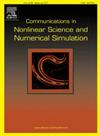Characterization of quasi-periodic dynamics of a magnetic nanoparticle
IF 3.4
2区 数学
Q1 MATHEMATICS, APPLIED
Communications in Nonlinear Science and Numerical Simulation
Pub Date : 2025-05-22
DOI:10.1016/j.cnsns.2025.108942
引用次数: 0
Abstract
This work presents a systematic characterization of the quasi-periodic dynamics of a uniaxial anisotropic magnetic nanoparticle under the influence of a time-varying external magnetic field. Using the Landau–Lifshitz–Gilbert (LLG) formalism, we analyze the response of the system as a function of key parameters, particularly focusing on the effects of magnetic anisotropy and dissipation. Through an extensive numerical exploration, we identify transitions between periodic, quasi-periodic, and chaotic regimes, employing Lyapunov exponents, isospike diagrams, Fourier spectra, and winding number calculations. The results reveal that the anisotropy parameter strongly influences the asymmetry of the dynamical states, leading to distinct behaviors along the easy and hard anisotropy axes. Additionally, at low dissipation, direct transitions between quasi-periodic and chaotic states emerge as a function of the external field, while at higher dissipation, periodic states dominate. The winding number analysis uncovers complex hierarchical structures, including self-similar step-like formations characteristic of the so-called Devil’s staircase phenomenon, along with a granular transition mechanism between quasi-periodic and chaotic states. Furthermore, the role of initial conditions is explored, demonstrating the presence of multistability, where different attractors coexist depending on the initial configuration. These results contribute to a deeper understanding of the nonlinear magnetization dynamics in anisotropic nanoparticles and may serve as a reference for future studies exploring the influence of quasi-periodic behavior in spintronic systems.
磁性纳米粒子的准周期动力学表征
本文系统地描述了在时变外磁场作用下单轴各向异性磁性纳米粒子的准周期动力学特性。利用Landau-Lifshitz-Gilbert (LLG)的形式,我们分析了系统的响应作为关键参数的函数,特别关注了磁各向异性和耗散的影响。通过广泛的数值探索,我们确定了周期,准周期和混沌制度之间的过渡,采用李雅普诺夫指数,等峰图,傅立叶谱和圈数计算。结果表明,各向异性参数强烈地影响了动态状态的不对称性,导致沿易、硬各向异性轴的不同行为。此外,在低耗散下,准周期态和混沌态之间的直接转换作为外场的函数出现,而在高耗散下,周期态占主导地位。圈数分析揭示了复杂的层次结构,包括所谓的魔鬼阶梯现象特征的自相似阶梯状结构,以及准周期和混沌状态之间的颗粒过渡机制。进一步探讨了初始条件的作用,证明了多稳定性的存在,即不同的吸引子根据初始构型共存。这些结果有助于深入理解各向异性纳米粒子的非线性磁化动力学,并可为进一步研究自旋电子系统中准周期行为的影响提供参考。
本文章由计算机程序翻译,如有差异,请以英文原文为准。
求助全文
约1分钟内获得全文
求助全文
来源期刊

Communications in Nonlinear Science and Numerical Simulation
MATHEMATICS, APPLIED-MATHEMATICS, INTERDISCIPLINARY APPLICATIONS
CiteScore
6.80
自引率
7.70%
发文量
378
审稿时长
78 days
期刊介绍:
The journal publishes original research findings on experimental observation, mathematical modeling, theoretical analysis and numerical simulation, for more accurate description, better prediction or novel application, of nonlinear phenomena in science and engineering. It offers a venue for researchers to make rapid exchange of ideas and techniques in nonlinear science and complexity.
The submission of manuscripts with cross-disciplinary approaches in nonlinear science and complexity is particularly encouraged.
Topics of interest:
Nonlinear differential or delay equations, Lie group analysis and asymptotic methods, Discontinuous systems, Fractals, Fractional calculus and dynamics, Nonlinear effects in quantum mechanics, Nonlinear stochastic processes, Experimental nonlinear science, Time-series and signal analysis, Computational methods and simulations in nonlinear science and engineering, Control of dynamical systems, Synchronization, Lyapunov analysis, High-dimensional chaos and turbulence, Chaos in Hamiltonian systems, Integrable systems and solitons, Collective behavior in many-body systems, Biological physics and networks, Nonlinear mechanical systems, Complex systems and complexity.
No length limitation for contributions is set, but only concisely written manuscripts are published. Brief papers are published on the basis of Rapid Communications. Discussions of previously published papers are welcome.
 求助内容:
求助内容: 应助结果提醒方式:
应助结果提醒方式:


